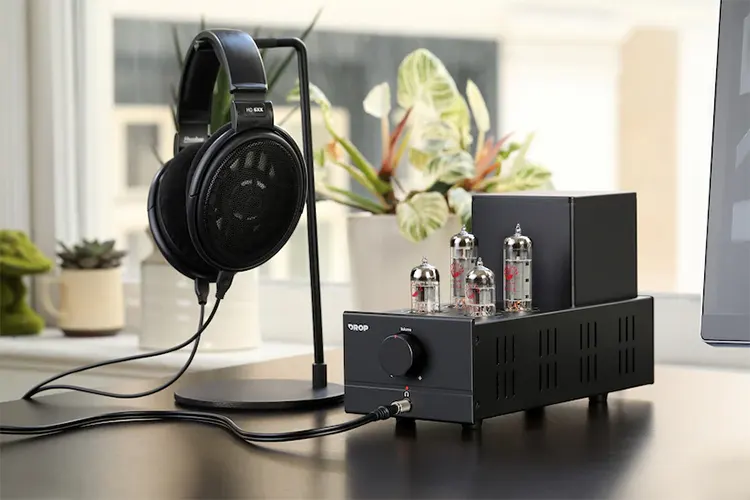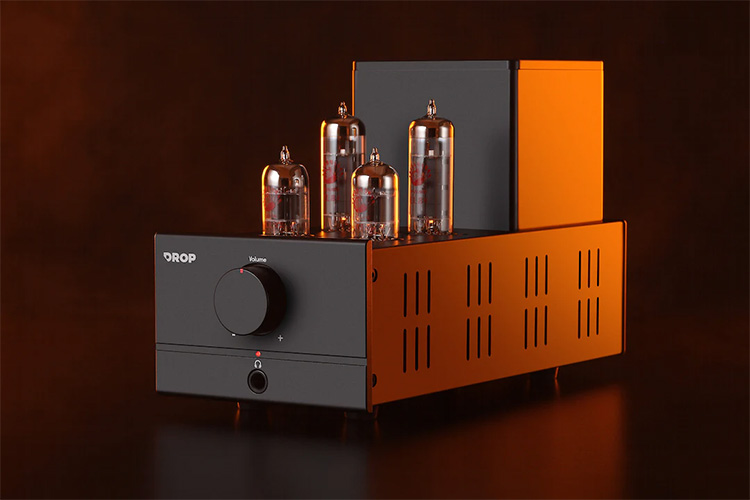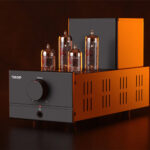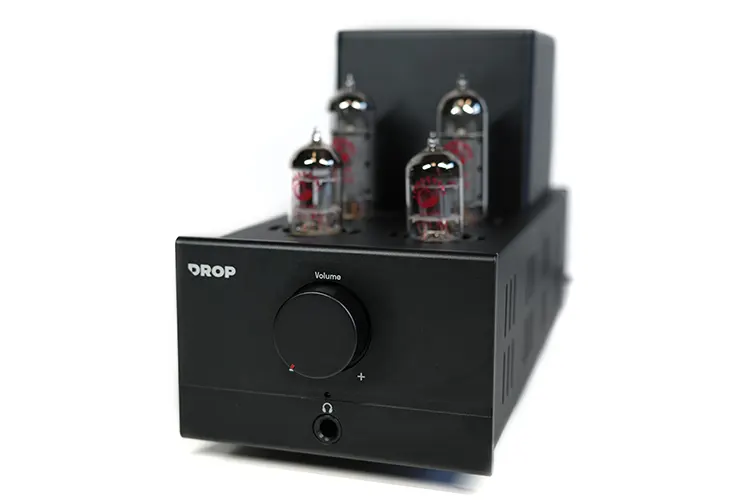In this feature, we review the Drop + xDuoo TA-84, which is an integrated desktop OTL tube amplifier and DAC designed for high-impedance headphones. It is priced at $349 for pre-orders, with an SRP of $399.
Disclaimer: This was sent to us as a sample in exchange for our honest opinion. Headfonics is an independent website with no affiliate links or services. We thank Drop for their support.
To learn more about Drop products previously assessed on Headfonics, you can click here.
Please note, that this article follows our current scoring guidelines which you can read in more detail here.
xDuoo is a popular brand in the audiophile world, with a wide range of amplifiers and source gear for headphones and IEM users.
We have covered quite a few of their desktop and portable amplifier products, such as the MT-604, the XA-10, and the cheaper TA-10 amplifier. xDuoo has an offering for pretty much everyone’s desktop headphone and speaker amplification needs without breaking the bank.
Today, we will be looking into their latest offering, a collaboration with Drop, called the TA-84, with a current price of $349.
The TA-84 is an OTL desktop tube amplifier that is modeled after xDuoo’s earlier TA-26 amplifier. Should this one be one of your 11.11 purchases for 2023? Let’s find out!
Tech Highlights
Tube Configuration
The TA-84 uses a total of 4 tubes (2 per channel) with dedicated power (EL-84) and pre-amplifier tubes (ECC-82).
All four are easily accessible top-load tubes for easy tube rolling, but the OEM PSVane tubes do an admirable job. Both tubes can be changed with aftermarket options, and xDuoo seems to appreciate that this can be done.
The noise floor is as black as a solid-state amplifier, and replacement OEM tubes can be had for roughly $40–$75 per pair, depending upon which pair you change.
The tubes are also matched as closely as possible since the two channels provide each side separately. Internal configurations help to minimize any discrepancy in tube variation.
Amplification Design
Designed as an OTL (Output Transformerless) tube amplifier, the TA-84 was specifically produced for high-impedance headphones such as the HD 6xx, or ZMF Headphones’ dynamic driver models such as the Atrium, as well as classic AKG 240 Studio models.
Power more than doubles (44mW @100Ω to 93mW @600Ω), but the amplifier is not recommended for use with planar headphones or sensitive IEMs as its specialty is good voltage rather than great current.
The TA-84 is also designed with an ES9018K2M reference DAC, engineered to handle up to 32BIT/384kHZ PCM bit rates, and it can also be paired with powered speakers that have sufficient internal power amplifiers.
Design
Aesthetics
There is an industrial look to the more powerful xDuoo amplifiers, and the TA-84 follows suit showing the tubes off in front of the boxed circuitry in the back. With a footprint very similar to the TA-26, the unit can easily fit on your desktop.
With the all-black anodization, there is a reminiscent look to row housing of early Industrial Revolution times. It also means business.
A knob on the front for the potentiometer volume wheel and a single 6.35mm jack underneath, dead center, adorn the front. There is a simplistic efficiency to the TA-84, which is refreshing as a result. I miss the chromed (or black on the TA-30) “protective” rails around the tubes, though.
The chassis is made of aluminum, and the sides carry ventilation fins to rid the unit of excess heat. It can still give off a fair bit of heat, and aluminum construction helps dissipate heat, too. There are also ventilation slots on the bottom.
Form Factor
The TA-84 is as long as the venerable TA-30, so it does take up a good length on your table (26.8 x 16.3 x 11.6 cm, LxHxW). With a weight of 3kg, the unit sits right about in the middle of the pack regarding heft.
Rubber feet elevate the TA-84 approximately ½” off the surface, which aids in dissipating excess heat from underneath. The ventilation slots on the bottom aid in the release of heat.
While it does share the design factor of the TA-30 and TA-26, the basic design combines both models to make a four-tube model, with a black color and narrower footprint.
I/O
The front carries only the volume potentiometer, a 6.35mm single-ended jack, and the “Drop” logo in the upper left.
Some may find a single notch to be either too much or not enough volume on the 42-step potentiometer. I found the gap to be acceptable. The TA-84 falls into the better-than-most category here.
The back carries the connectivity options as well as a power plug, replaceable fuse, gain switch (H-L, with 16dB difference), and power cord plug.
The H-L gain switch is easily accessed by reaching around to the top right, with the input option switch directly below. One could easily have both a USB and AUX source hooked into the TA-84 while switching between the two (as I did).
RCA connections for the source in and pre-amp out are to the right of the gain/source switches, while a user-replaceable fuse is next to those connections.
The power switch is above the plug and easily accessible. A green light signifies when the unit has warmed sufficiently for use, which reflects nicely on a wall.
Packaging & Accessories
xDuoo has always packaged its goods well, giving extra care to the tubes. A single-layer box carries medium foam-fitting shapes to hold the tubes and the unit itself.
The power cord comes in a protective paperboard box above the tubes, and the unit comes in stock with PSVane tubes, which is an upgrade to previous xDuoo models.
The only accessory included is a USB-A to USB-C cable. The included USB-C cable allows for quick connectivity with devices that either use USB-A or a USB-C to USB-C cable (or with an adapter).
The majority of my testing was done this way, hooking to my Shanling M6 Pro or Cayin N6ii MKII.
Sound Impressions
The following sound impressions were made with the Drop x Sennheiser HD 6xx (300 Ω, provided), ZMF Eikon (350Ω), AKG240DF (600Ω, Edifier R1280T, and FiiO FT3 (350Ω). Sources included my MacBook Pro (briefly), Shanling M6 Pro, and Cayin N6ii with the E01 motherboard.
Summary
Tube amplifiers usually promote a smoother, warmer signature, and the TA-84 mostly follows this.
The TA-30 is known for its insane power output, while the TA-84 is oriented towards high-impedance headphones with less power. A V-shaped signature, bordering on an L-shape, with less upper mid and lower treble push, gives the listener a smooth overall presentation.
The high-impedance headphones, which are what the TA-84 is geared for, provide plenty of headroom with a decent expanse as well. Dynamics and clarity are very acceptable for the price point. None of the tested headphones were left wanting more power. A testament to the design specificity.
The limiting factor in sound is the choice of tubes. While the PSVane tubes are generally good, rolling after-market tubes will provide the user with more options.
The stock tubes do give good bass reach while promoting the upper mids (but not as much) to counter that push. Mids are pushed forward but not elevated, which is a nice change.
Coloration
Tube choices dictate the sound response, as mentioned, and the PSVane makes an economical start for a reasonably priced amplifier.
Warmth and power exuded from all headphones tested, and there was a certain sweetness to the sound, especially with the AKG and ZMF headphones.
Where the TA-30 is insanely powerful to get the point across, the TA-84 exhibited more warmth in the signature and a mellower character.
That warmth did not turn into sloppy handling, either. The low end was fairly taut, with a slower decay than attack, which allowed the low end to linger.
The tube-goodness down low was showcased, and here the PSVane tubes helped over previous stock tubes. Typically, new tubes from the Far East tend to bring a brighter character to the signature, but there was a good richness to the music.
The mids are what did it for me. A warm signature exuded confidence with the notes, which belied a typical tube “slowness.” There was still the slow-natured feel, but the attack came about with an abruptness, which also gave a slight thinning of notes.
The quickening pace allowed me to enjoy the sound without the typically drawn-out nature of tubes on both sides of a note. The longer decay helped to keep the musicality for a nice balance.
I was never left wanting more power, either. Keeping the gain setting on high, I never needed to move the volume pot past 1100 for high-level listening.
The sound was spacious and full, too. Tube sound helps fill in the spatial area, and there was never a lack of fullness to the notes. And there was no bloating, either. The combination of quicker attack and slower decay combined nicely for a full-weighted note in songs.

Dynamics
Tube amplifiers are not generally known for fast transient response, and the TA-84 is not that much different. But the weight of each note is such that I do not miss the speediness necessitated by a faster overall response.
This amplifier is meant for a smooth character with richness in detail instead of pinpoint accuracy. As such, it is a very pleasant listen. I will, of course, admit my liking for a smoother, warmer signature.
There is a good resolution (and character), but you should look at the whole thing rather than picking parts out. Dynamics take a hit with the smooth character but remain engaging with the EL84 tubes.
This is a case where the whole is greater than the sum of the parts. If a detailed resolution is what you are after, then you should probably look elsewhere.
Female vocals sounded sumptuous, with excellent note depth and feel from the combinations noted above. Note weight provided an excellent character, which made up for any lack of details. The PSVane tubes present a very good smoothness to the signature as a result, which to me overshadows any perceived lack of clarity.
Soundstage
The soundstage is on the more intimate side regarding width and depth. Height gives room for the sound to expand without losing too much detail. Instead of breathing outward, the weight of notes expands upward, allowing each part to show good authority.
Even with the characteristics listed above, imaging is good, and the placement of instruments or vocals can occur with reasonable accuracy. What I notice is that when an instrument comes forward, it does so with good authority but can become a little harsh in presentation.
When you break down instrumentation, it does suffer from complex songs. But taken together, the melding is more appropriate. Detail retrieval is what you would expect from a $300 tube amplifier. Good, but not great.
Click on page 2 below for our recommended pairings and selected comparisons.







